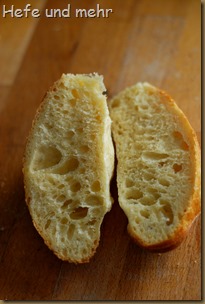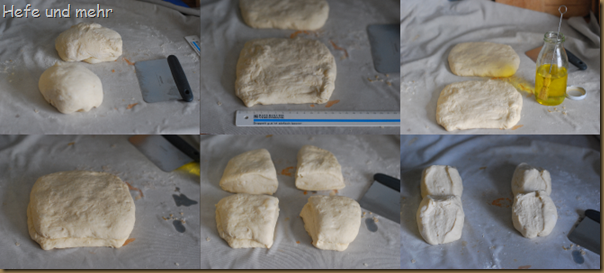 We spent our last summer holiday in the Alsace. And we enjoyed the beautiful landscape, the food and the niece people there very and much – and the bakeries,too! During our holidays I scribbled down a list with breads I had to bake when I’m back home.
We spent our last summer holiday in the Alsace. And we enjoyed the beautiful landscape, the food and the niece people there very and much – and the bakeries,too! During our holidays I scribbled down a list with breads I had to bake when I’m back home.
Among the breads of this list was the Pain Pavé as well as this Sübrot. Sü comes from Sou which means a very small coin and Brot means bread so Sübrot can be translated to “Penny bread”. During wartimes it was a cheap bread that due to its form could be purchased in pieces as well. And even nowadays I was asked if I wanted the whole loaf or only a part of it when I bought it in a Boulangerie in Strasbourg.
Back home, when I decided to bake my own version, I decided to go to a slow rising dough, which fermented over night at roomtemperature. The next morning I divided the dough, shaped two squares and spread a thin layer of oil on top of one of them. The oil layer hast to be really thin to ensure that the bread do not unfold to quickly in the oven, so I removed a part of it again with a paper towel. And that worked very well, indeed. I was sit in front of the oven all the time, fascinated by the unfolding bread.
And the finished bread is a treat, too: Open crumb, crisp crust and a mild but complex taste!
Sübrot
yields 2 Sübrots 
Dough
- 400g flour Type 550
- 275g cold Water
- 3g fresh yeast
- 8g Salt
Mix flour with water and let it rest for 20min (autolysis). Now add yeast and salt and knead for5 min by hand. Let it rest for 30 min, then fold it from the outside of bowl into the middle for three or four times.
Ferment the dough for 12 hours (overnight) at room temperature.
The next morning heat baking stone in the oven to 250°C. In the meantime divide the dough into two pieces and press each piece into a square of 15 cm x 15 cm. Spread a thin layer of oil on top of one of the square. Remove a part of the oil again with a paper towel, to ensure that it is a really thin layer! 
Now place the other dough square on top and cut it into four squares. Place two squares upright with a tip facing upright.
Proof on a couche for 35 min.
Bake the loaves on the hot stone for 22 min at 250°C with steam, until the crust is golden brown.
Deutsch



Liebe Stefanie, ich habe das Sübrot bereits einmal mit Erfolg gebacken, aber vergessen, ob Trockenhefe oder frische Hefe bei drei Gramm richtig ist.
Vielen ♥ lieben Dank!
Rudolf
@Rudolf: Frische Hefe 🙂 Siehe hier
Wir geniessen gerade Sübrot. Meine Mädels sind begeistert. Danke für die vielen Rezepte. Wir essen praktisch nur noch Brote nach Rezept n von Hefe-und-mehr.
Liebe Grüsse aus dem Berneroberland
Hi Steffi,
Our favourite breads are Pain Pave and Subrot. In your Subrot comments you mention that you have a list of breads to try from your vacation in France. Recently, you asked for suggestions on “old” recipes, so I was wondering if you still had the list and could make more French breads like Pain Pave and Subrot.
Theresa
@Theresa: On my list was what I eat in Alsac:
Kugelhopf
Sübrot(see above)
Pain Pavé
Baguette pavot
Baguette levain (in this case, I used sweet starter)
Brioche (a spelt variant is on its way, too)
So if you have more suggestions I’m happy to take them 🙂
Hallo Stefanie,
dein Sübrot hat mich schon lange angelacht und am WE hab ich es gleich zweimal gebacken-als Weizen- und dann als Dinkelversion! Mhhhhhhh … lecker! Und es hat super ausgesehen-spitzen Beschreibung deinerseits!
Jetzt hab ich eine kleine Frage: ich würde statt 2 gern 4 Brote aus der gleichen Menge als Partybrot machen, würdest Du die Backzeit reduzieren und wenn ja auf wieviel? Dachte so an 18 bis 20 min … Bei Brot in normaler Form hab ich den Dreh mit der Backzeit langsam raus, aber bei Brötchen ist das nicht so leicht! Sie sollen ja auch schön knusprig aber nicht trocken werden.
Danke und eine schöne Woche!
Liebe Grüße Jasmin
@Jasmin: schön, dass es mit der Beschreibung gut geklappt hat 🙂 Und die Dinkelvariante ist eine gute Idee, ich mag den nussigen Geschmack von Dinkel in hellem Gebäck sehr.
Was die verkürzte Backzeit bei kleinerem Gebäck angeht, solltest du mit 18 min gut hinkommen.
Pingback: Baguette-Variationen | Hefe und mehr
Hallo stefanie, habe heute das Brot gebacken. Es ging wunderschön auf. Habe nur den Teig leicht verändert. Statt reinem WM hab ich etwas Dinkelvollkorn dazugetan. und etwas mehr Wasser. Wunderschön! danke für das tolle Rezept!
LG
@Alexandra: Dass das Brot mit Dinkelvollkornmehl-Beigabe gut schmeckt, kann ich mir vorstellen! Eine gute Idee!
Ich habe schon die Krustis gebacken einfach Traumweckle hab gleich die doppelte Menge gemacht ,habe allerdings das Buch gekauft ,tolles Buch gruss Brigitte
Ich war ja schon äusserst angetan vom Pain Pave und habe spontan entschieden den Versuch Sübrot auch noch., zu wagen.
Der liegt jetzt in der Couche …sehr weicher Teig ….ich hab ja ein wenig “Fracksausen “…ob und wie ich den Teig von der Couch auf den Stein bekomme …Kippdiele?
Kein Brot für Anfänger …aber ich bin gespannt!
@Chorus: Ich habe eine Kippdiele bzw. einen 2. Brotschieber verwendet. Ich bin gespannt, ob dir das Brot gefällt!
Es ist geschmacklich toll …hast du einen Facebook Account? Ich werde noch am Erscheiungsbild feilen müssen …mein Ehrgeiz ist geweckt …ein tolles Rezept und mit ein wenig Erfahrung auch gut umzusetzen …ganz grossartig!
@Chorus: Kein Gesichtsbuch-Account, nein. Und es freut mich, dass es dir schmeckt! Falls der Teig zu weich ist, kannst du es mit 5-10g weniger Wasser versuchen. Liebe Grüße, Stefanie
Hi Stepfanie,
About the formation of the loaves. I get the instructions as far as cutting the squares into 4 pieces. But I am not sure what , ” Place two squares upright with the a tip facing upright. ” means. Are you splitting each of the 4 sections so you end up with 4 loaves as shown in the first picture at the top of your post? I didn’t think so, but I thought I’d better ask if I am going to try making these loaves.
I really enjoy your website and your recipes. Thanks. R.
@Rod: You place two of the small squares next to each other with one of the tips facing upright. In the oven the oil between the dough layers will help the bread to crack open and unfold, forming the splitted loaf you can see in the first picture. You will get two of this loaves (the amount you see in the picture).
“Proof on a couch for 35 min.”
Hi. Wirklich auf einer Couch? 🙂
@HansQ35: Ähm…hüstel… da reiche ich noch ein “e” nach, bevor noch jemand auf falsche Gedanken kommt 😉
WOW sieht das toll aus 🙂 Hab ich noch nie gesehen, erinnert ein bisschen an das Pain Beaucaire oder? Ach Stefanie Du verlängerst meine Nachbackliste im Stundentakt 😉 Habe die Woche Dein Mohn-Sandwichbrot gebacken – ein Träumchen, so lecker und wirklich ungetoastet wie getoastet sehr lecker. Schönes Wochenende. Herzlichst Nadja
@Naddi: Vor meinem Elsass-Urlaub kannte ich es auch nicht, war aber direkt angetan von der Form. Und das Prinzip ist dem Pain de Beaucaire wirklich sehr änlich. Durch das Öl springen die Teigplatten aber deutlich weiter auf, so dass man Ende vier “Brötchen” erhält.
Auch dir ein schönes Wochenende, genieß die Sonne!